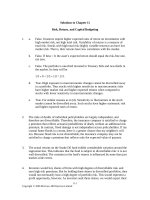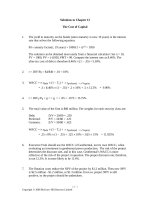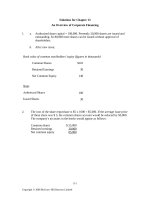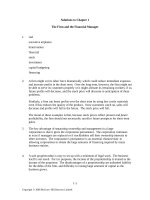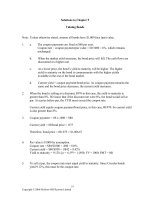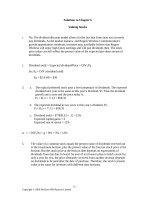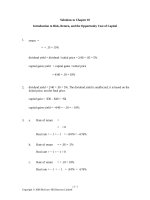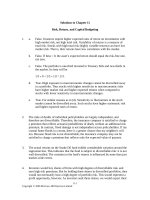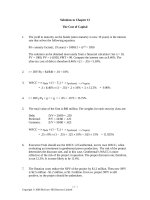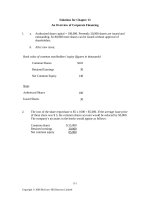Solution manal of algebral
Bạn đang xem bản rút gọn của tài liệu. Xem và tải ngay bản đầy đủ của tài liệu tại đây (824.16 KB, 53 trang )
2-1
Solutions for Chapter 2 Problems
1. Vectors in the Cartesian Coordinate System
P2.1: Given P(4,2,1) and APQ=2ax +4ay +6az, find the point Q.
APQ = 2 ax + 4 ay + 6 az = (Qx-Px)ax + (Qy-Py)ay+(Qz-Pz)az
Qx-Px=Qx-4=2; Qx=6
Qy-Py=Qy-2=4; Qy=6
Qz-Pz=Qz-1=6; Qz=7
Ans: Q(6,6,7)
P2.2: Given the points P(4,1,0)m and Q(1,3,0)m,
the vectors found in (a) through (f).
Vector
a. Find the vector A
AOP = 4 ax + 1 ay
from the origin to P
b. Find the vector B
BOQ = 1 ax + 3 ay
from the origin to Q
c. Find the vector C
CPQ = -3 ax + 2 ay
from P to Q
d. Find A + B
A + B = 5 ax + 4 ay
e. Find C – A
C - A = -7 ax + 1 ay
f. Find B - A
B - A = -3 ax + 2 ay
fill in the table and make a sketch of
Mag
4.12
Unit Vector
AOP = 0.97 ax + 0.24 ay
3.16
aOQ = 0.32 ax + 0.95 ay
3.61
aPQ = -0.83 ax + 0.55 ay
6.4
7.07
3.6
a = 0.78 ax + 0.62 ay
a = -0.99 ax + 0.14 ay
a = -0.83 ax + 0.55 ay
a. AOP = (4-0)ax + (1-0)ay + (0-0)az = 4 ax + 1 ay.
AOP = 42 + 12 = 17 = 4.12
4
1
ax +
a y = 0.97ax + 0.24a y
17
17
(see Figure P2.2ab)
aOP =
b. BOQ =(1-0)ax + (3-0)ay + (0-0)az = 1 ax + 3 ay.
BOQ = 12 + 32 = 10 = 3.16
Fig. P2.2ab
1
3
ax +
a y = 0.32ax + 0.95a y
10
10
(see Figure P2.2ab)
aOQ =
c. CPQ = (1-4)ax + (3-1)ay + (0-0)az = -3 ax + 2 ay.
C PQ = 32 + 2 2 = 13 = 3.61
−3
2
ax +
a y = −0.83ax + 0.55a y
13
13
(see Figure P2.2cd)
a PQ =
Fig. P2.2cd
2-2
d. A + B = (4+1)ax + (1+3)ay + (0-0)az = 5 ax + 4 ay.
A + B = 52 + 42 = 41 = 6.4
5
4
ax +
a y = 0.78ax + 0.62a y
41
41
(see Figure P2.2cd)
a=
e. C - A = (-3-4)ax + (2-1)ay + (0-0)az = -7 ax + 1 ay.
C − A = 72 + 12 = 50 = 7.07
−7
1
ax +
a y = −0.99ax + 0.14a y
50
50
(see Figure P2.2ef)
a=
FigP2.2ef
f. B - A = (1-4)ax + (3-1)ay + (0-0)az = -3 ax + 2 ay.
B − A = 32 + 22 = 13 = 3.6
−3
2
ax +
a y = −0.83ax + 0.55a y
13
13
(see Figure P2.2ef)
a=
P2.3: MATLAB: Write a program that will find the vector between a pair of arbitrary
points in the Cartesian Coordinate System.
A program or function for this task is really overkill, as it is so easy to perform the task.
Enter points P and Q (for example, P=[1 2 3]; Q=[6 5 4]). Then, the vector from P toQ is
simply given by Q-P.
As a function we could have:
function PQ=vector(P,Q)
%
Given a pair of Cartesian points
%
P and Q, the program determines the
%
vector from P to Q.
PQ=Q-P;
Running this function we have:
>> P=[1 2 3];
>> Q=[6 5 4];
>> PQ=vector(P,Q)
PQ =
5
3
1
Alternatively, we could simply perform the math in the command line window:
2-3
>> PQ=Q-P
PQ =
5 3 1
>>
2. Coulomb’s Law, Electric Field Intensity, and Field Lines
P2.4: Suppose Q1(0.0, -3.0m, 0.0) = 4.0nC, Q2(0.0, 3.0m, 0.0) = 4.0nC, and Q3(4.0m,
0.0, 0.0) = 1.0nC. (a) Find the total force acting on the charge Q3. (b) Repeat the problem
after changing the charge of Q2 to –4.0nC. (c) Find the electric field intensity for parts (a)
and (b).
(a) F13 =
so
Q1Q2
a13 , where R13 = 4 ax + 3 ay =, R13 = 5m, a13 = 0.8 ax + 0.6 ay.
4πε o R132
( 4a + 3a )
4 x10 C )(1x10 C )
(
5
=
4π (10 F 36π m ) ( 5m )
−9
F13
−9
x
y
2
−9
FV NM
C VC
= 1.15 x10−9 ax + 0.86 x10−9 a y N .
Similarly, F23 = 1.15 x10−9 ax − 0.86 x10−9 a y N , so FTOT = 2.3a x nN
(b) with Q2 = -4 nC, F13 is unchanged but F23 = −1.15x10−9 ax + 0.86 x10−9 a y N , so
FTOT = 1.7a y nN .
−9
FTOT ( 2.3x10 ax N ) VC
V
(c) Ea =
=
= 2.3ax .
-9
Q3
m
(1x10 C ) Nm
Likewise, Eb = 1.7a y
V
.
m
Fig. P2.4
P2.5: Find the force exerted by Q1(3.0m, 3.0m, 3.0m) = 1.0 µC on Q2(6.0m, 9.0m, 3.0m)
= 10. nC.
Q1Q2
a12 , where
4πε o R122
R12 = (6-3)ax + (9-3)ay + (3-3)az = 3 ax + 6 ay m
3a + 6a y
R12 = 32 + 62 = 45m, a12 = x
, and
45
F12 =
2-4
(1x10 C )(10 x10 C ) 3a
=
4π (10 F
45m )
36π m ) (
−6
F12
−9
−9
2
x
+ 6a y FV NM
, so F12 = 0.89ax + 1.8a y µ N .
C VC
45
Fig. P2.5
P2.6: Suppose 10.0 nC point charges are located on the corners of a square of side 10.0
cm. Locating the square in the x-y plane (at z = 0.00) with one corner at the origin and
one corner at P(10.0, 10.0, 0.00) cm, find the total force acting at point P.
We arbitrarily label the charges as shown in Figure P2.6. Then
ROP = 0.1 ax + 0.1 ay
ROP = 0.141 m
aOP = 0.707 ax + 0.707 ay.
FOP =
(10nC )(10nC )( 0.707 ) ( ax + a y )
−9
2
( 4π ) 10 F 36π m ( 0.141m )
(
)
= 32 ( a x + a y ) µ N
FTP =
FSP =
(10nC )(10nC ) ay
−9
2
( 4π ) 10 F 36π m ( 0.1m )
= 90a y µ N
(10nC )(10nC ) ax
−9
2
( 4π ) 10 F 36π m ( 0.1m )
= 90a x µ N
(
(
)
)
Fig. P2.6
and then the total (adjusting to 2 significant digits) is:
FTOT = 120 ( a x + a y ) µ N .
2-5
P2.7: 1.00 nC point charges are located at (0.00, -2.00, 0.00)m, (0.00, 2.00, 0.00)m, (0.00,
0.00, -2.00)m and (0.00, 0.00, +2.00)m. Find the total force acting on a 1.00 nC charge
located at (2.00, 0.00, 0.00)m.
Figure P2.7a shows the situation, but we need only find the x-directed force from one of
the charges on Qt (Figure P2.7b) and multiply this result by 4. Because of the problem’s
symmetry, the rest of the components cancel.
2a + 2a y
QQt
F1t =
a R , R = 2a x + 2a y , R = 8 m, a R = x
,
4πε o R
8
(1x10−9 C )(1x10−9 C ) ⎛⎜⎝ 2a x + 2a y 8 ⎞⎟⎠
so F1t =
= 796 x10−12 ( a x + a y ) N
−9
4π 10 F
8m 2 )
36π m (
The force from all charges is then
FTOT = ( 4 ) ( 796 x10−12 a x ) nN = 3.2a x nN .
)
(
Fig. P2.7a
Fig. P2.7b
P2.8: A 20.0 nC point charge exists at P(0.00,0.00,-3.00m). Where must a 10.0 nC
charge be located such that the total field is zero at the origin?
For zero field at the origin, we must cancel the +az directed field from QP by placing Q at
the point Q(0,0,z) (see Figure P2.8). Then we have Etot = EP + EQ = 0.
20 x10−9 C ) a z
(
QP
FV
V
So, E P =
a =
= 20a z
2 R
−9
2
m
4πε o R
4π 10 F
3m C
36π m ( )
(
)
2-6
and
EQ =
Q
4πε o R 2
aR
(10 x10 C ) (−a )
−9
=
(
z
−9
4π 10 F
36π m
) ( z ( m) )
2
=
−90
az
z2
So then
90
20a z − 2 a z = 0,
z
90
z 2 = , z = 2.12.
20
Thus, Q(0,0,2.12m).
Fig. P2.8
3. The Spherical Coordinate System
P2.9: Convert the following points from Cartesian to Spherical coordinates:
a. P(6.0, 2.0, 6.0)
b. P(0.0, -4.0, 3.0)
c. P(-5.0,-1.0, -4.0)
⎛ 6 ⎞
o
−1 ⎛ 2 ⎞
o
(a) r = 62 + 22 + 62 = 8.7, θ = cos −1 ⎜
⎟ = 47 , φ = tan ⎜ ⎟ = 18
⎝ 8.7 ⎠
⎝6⎠
⎛3⎞
⎛ −4 ⎞
(b) r = 02 + 42 + 32 = 5, θ = cos −1 ⎜ ⎟ = 53o , φ = tan −1 ⎜ ⎟ = −90o
⎝5⎠
⎝ 0 ⎠
⎛ −4.0 ⎞
o
−1 ⎛ − 1 ⎞
o
(c) r = 52 + 12 + 42 = 6.5, θ = cos −1 ⎜
⎟ = 130 , φ = tan ⎜ ⎟ = 190
⎝ 6.5 ⎠
⎝ −5 ⎠
P2.10:
a.
b.
c.
Convert the following points from Spherical to Cartesian coordinates:
P(3.0, 30.°, 45.°)
P(5.0, π/4, 3π/2)
P(10., 135°, 180°)
(a)
x = r sin θ cos φ = 3sin 30o cos 45o = 1.06
y = r sin θ sin φ = 3sin 30o sin 45o = 1.06
z = r cos θ = 3cos 30o = 2.6
so P (1.1,1.1, 2.6).
(b)
2-7
x = r sin θ cos φ = 5sin 45o cos 270o = 0
y = r sin θ sin φ = 5sin 45o sin 270o = −3.5
z = r cos θ = 5cos 45o = 3.5
so P (0, −3.5,3.5).
(c)
x = r sin θ cos φ = 10sin135o cos180o = −7.1
y = r sin θ sin φ = 10sin135o sin180o = 0
z = r cos θ = 10 cos135o = −7.1
so P (−7.1, 0, −7.1).
P2.11: Given a volume defined by 1.0m ≤ r ≤ 3.0m, 0 ≤ θ ≤ 0°, 90° ≤ φ ≤ 90°, (a)
sketch the volume, (b) perform the integration to find the volume, and (c) perform the
necessary integrations to find the total surface area.
(a)
Fig. P2.11
(b)
3
90o
π 2
0
0
V = ∫∫∫ r sin θ drdθ dφ = ∫ r dr ∫ sin θ dθ
2
2
1
3
∫ dφ =
13π
= 13.6m3 .
3
So volume V = 14 m .
(c) There are 5 surfaces: an inner, an outer, and 3 identical sides.
3
S side = ∫∫ rdrdφ = ∫ rdr
1
π 2
∫ dφ = 2π m ;
0
Souter = ∫∫ r sin θ dθ dφ = 3
2
π
2
90o
π 2
0
0
∫ sin θ dθ ∫ dφ =
m 2 ; STOT = 11π m 2 = 34.6m 2
2
So Stotal = 35 m2.
Sinner =
S sides = 6π m 2
2
9π 2
m
2
2-8
4. Line Charges and the Cylindrical Coordinate System
P2.12: Convert the following points from Cartesian to cylindrical coordinates:
a. P(0.0, 4.0, 3.0)
b. P(-2.0, 3.0, 2.0)
c. P(4.0, -3.0, -4.0)
⎛4⎞
(a) ρ = 02 + 42 = 4, φ = tan −1 ⎜ ⎟ = 90o , z = 3, so P (4.0,90o ,3.0)
⎝0⎠
⎛ 3 ⎞
(b) ρ = 22 + 32 = 3.6, φ = tan −1 ⎜ ⎟ = 124o , z = 2, so P (3.6,120o , 2.0)
⎝ −2 ⎠
⎛ −3 ⎞
(c) ρ = 42 + 32 = 5, φ = tan −1 ⎜ ⎟ = −37 o , z = −4, so P (5.0, −37 o , −4.0)
⎝ 4 ⎠
P2.13:
a.
b.
c.
Convert the following points from cylindrical to Cartesian coordinates:
P(2.83, 45.0°, 2.00)
P(6.00, 120.°, -3.00)
P(10.0, -90.0°, 6.00)
(a)
x = ρ cos φ = 2.83cos 45o = 2.00
y = ρ sin φ = 2.83sin 45o = 2.00
z = z = 2.00
so P(2.00, 2.00, 2.00).
(b)
x = ρ cos φ = 6.00 cos120o = −3.00
y = ρ sin φ = 6.00sin120o = 5.20
z = z = −3.00
so P(−3.00,5.20, −3.00).
(c)
x = ρ cos φ = 10.0 cos(−90.0o ) = 0
y = ρ sin φ = 10.0sin(−90.0o ) = −10.0
z = z = 6.00
so P(0, −10.0, 6.00).
P2.14: A 20.0 cm long section of copper pipe has a 1.00 cm thick wall and outer
diameter of 6.00 cm.
a. Sketch the pipe conveniently overlaying the cylindrical coordinate system, lining
up the length direction with the z-axis
b. Determine the total surface area (this could actually be useful if, say, you needed
to do an electroplating step on this piece of pipe)
c. Determine the weight of the pipe given the density of copper is 8.96 g/cm3
2-9
(a) See Figure P2.14
(b) The top area, Stop, is equal to the bottom area. We must also find the inner area, Sinner,
and the outer area, Souter.
3
2π
2
0
Stop = ∫∫ ρ d ρ dφ = ∫ ρ d ρ ∫ dφ = 5π cm2 .
Sbottom = Stop .
2π
20
0
0
Souter = ∫∫ ρ dφ dz = 3 ∫ dφ ∫ dz = 120π cm 2
2π
20
0
0
Sinner == ∫∫ ρ dφ dz = 2 ∫ dφ ∫ dz = 80π cm 2
The total area, then, is 210π cm2, or Stot = 660 cm2.
(c) Determining the weight of the pipe requires the volume:
V = ∫∫∫ ρ d ρ dφ dz
3
2π
20
2
0
0
= ∫ ρ d ρ ∫ dφ ∫ dz = 100π cm3 .
g ⎞
⎛
M pipe = ⎜ 8.96 3 ⎟ (100π cm3 )
cm ⎠
⎝
= 2815 g.
So Mpipe = 2820g.
Fig. P2.14
P2.15: A line charge with charge density 2.00 nC/m exists at y = -2.00 m, x = 0.00. (a) A
charge Q = 8.00 nC exists somewhere along the y-axis. Where must you locate Q so that
the total electric field is zero at the origin? (b) Suppose instead of the 8.00 nC charge of
part (a) that you locate a charge Q at (0.00, 6.00m, 0.00). What value of Q will result in a
total electric field intensity of zero at the origin?
(a) The contributions to E from the line and point charge must cancel, or E = E L + EQ .
For the line: E L =
( 2nC / m )
ρL
V
aρ =
a y = 18 a y
−9
2πε o ρ
m
2π 10 F
2m
36π m ( )
(
)
2-10
and for the point charge, where the point is located a distance y along the y-axis, we
(8nC ) ( −a y )
Q
72
have: EQ =
−
=
= 2 ( −a y )
a
(
)
y
2
−9
4πε o y
4π 10 F
y2 y
36π m
Therefore:
72
72
= 18, or y =
= 2m.
2
y
18
)
(
So Q ( 0,2.0m,0 )
(b)
Q
4πε o ( 6 )
Q=
2
= 18,
(18)( 36 ) = 72nC.
9
Fig. P2.15
P2.16: You are given two z-directed line charges of charge density +1 nC/m at x = 0, y =
-1.0 m, and charge density –1.0 nC/m at x = 0, y = 1.0 m. Find E at P(1.0m,0,0).
The situation is represented by Figure P2.16a. A better 2-dimensional view in Figure
P2.16b is useful for solving the problem.
⎛ a + ay ⎞
ρ L1
E1 =
a ρ , and ρ a ρ = 2 ⎜ x
⎟.
2πε o ρ
2 ⎠
⎝
(1x10 C )
−9
E1 =
(
−9
2π 10 F
36π m
So ETOT = 18 ay V/m.
Fig. P2.16a
) ( 2m )
(a
x
+ a y ) FV
V
V
= 9 ( a x + a y ) , and E 2 = 9 ( -a x + a y ) .
C
m
m
2
Fig. P2.16b
2-11
P2.17: MATLAB: Suppose you have a segment of line charge of length 2L centered on
the z-axis and having a charge distribution ρL. Compare the electric field intensity at a
point on the y-axis a distance d from the origin with the electric field at that point
assuming the line charge is of infinite length. The ratio of E for the segment to E for the
infinite line is to be plotted versus the ratio L/d using MATLAB.
This is similar to MATLAB 2.3. We have for the ideal case
ρL
ρL
Eideal =
aρ =
aρ .
2πε o ρ
2πε o d
For the actual 2L case, we have an integration to perform (Equation (2.35) with different
limits):
Eactual
ρ ρa
= L ρ
4πε o
Eactual =
+L
+L
∫
−L
(ρ
dz
2
+ z2 )
32
ρ L da y ⎡
⎤
z
=
⎢ 2 2
⎥
4πε o ⎣ d z + d 2 ⎦ − L
ρ La y ⎛
⎞
L
⎜ 2
⎟.
2πε o d ⎝ L + d 2 ⎠
Now we manipulate these expressions to get the following ratio:
L
Eactual
d
=
.
2
Eideal
L
1+
d
In the program, the actual to ideal field ratio is termed “Eratio” and the charged line halflength L ratioed to the distance d is termed “Lod”.
( )
%
%
%
%
%
%
%
%
%
%
%
%
%
%
%
M-File: MLP0217
This program is similar to ML0203.
It compares the E-field from a finite length
segment of charge (from -L to +L on the z-axis)
to the E-field from an infinite length line
of charge. The ratio (E from segment to E from
infinite length line) is plotted versus the ratio
Lod=L/d, where d is the distance along the y axis.
Wentworth, 12/19/02
Variables:
Lod
Eratio
clc
clear
the ratio L/d
ratio of E from segment to E from line
%clears the command window
%clears variables
%
Initialize Lod array and calculate Eratio
Lod=0.1:0.01:100;
2-12
Eratio=Lod./(sqrt(1+Lod.^2));
%
Plot Eratio versus Lod
semilogx(Lod,Eratio)
grid on
xlabel('Lod=L/d')
ylabel('E ratio: segment to line')
Executing the program gives Figure P2.17.
Fig. P2.17
So we see that the field from a line segment of charge appears equivalent to the field
from an infinite length line if the test point is close to the line.
P2.18: A segment of line charge ρL =10 nC/m exists on the y-axis from the origin to y =
+3.0 m. Determine E at the point (3.0, 0, 0)m.
It is clear from a sketch of the problem in Figure P2.18a that the resultant field will be
directed in the x-y plane. The situation is redrawn in a temporary coordinate system in
Figure P2.18b.
We have from Eqn (2.34) E = ∫
ρ L dz ρ a ρ − za z
= Eρ a ρ + E z a z .
4πε o ρ 2 + z 2 3 2
(
)
For Eρ we have:
ρ ρ
Eρ = L
4πε o
∫
dz
(ρ
2
+ z2 )
3
2
ρ ρ
= L
4πε o
⎡
z
⎢ 2 2
⎢⎣ ρ z + ρ 2
With ρ = 3, we then have Eρ = 21.2 V/m.
For Ez:
3
⎤
⎥
⎥⎦ 0
2-13
Fig. P2.18b
Fig. P2.18a
−ρL
Ez =
4πε o
∫
zdz
(ρ
2
+ z2 )
3
2
ρ ⎛
1
= L ⎜
2
4πε o ⎝⎜ ρ + z 2
3
⎞
V
⎟ = −8.79
⎟
m
⎠ z =0
Thus we have ETOT = 21 aρ – 8.8 az V/m.
Converting back to the original coordinates, we have ETOT = 21 ax – 8.8 ay V/m.
5. Surface and Volume Charge
P2.19: In free space, there is a point charge Q = 8.0 nC at (-2.0,0,0)m, a line charge ρL =
10 nC/m at y = -9.0m, x = 0m, and a sheet charge ρs = 12. nC/m2 at z = -2.0m.
Determine E at the origin.
The situation is represented by Figure P2.19, and the total field is ETOT = EQ + EL + ES.
(8x10−9 C ) a x
Q
EQ =
a
=
R
−9
2
4πε o R 2
4π 10 F
2m
36π m ( )
V
= 18a x
m
10 x10−9 C m ) a y
(
ρL
EL =
aρ =
−9
2πε o ρ
2π 10 F
9m
36π m ( )
V
= 20a y
m
12 x10−9 C m 2 )
(
ρs
Es =
aN =
az
−9
2ε o
2 10 F
36π m
Fig. P2.19
V
= 679a z
m
So: Etot = 18 ax + 20 ay + 680 az V/m.
)
(
)
(
(
)
2-14
P2.20: An infinitely long line charge (ρL = 21π nC/m) lies along the z-axis. An infinite
area sheet charge (ρs = 3 nC/m2) lies in the x-z plane at y = 10 m. Find a point on the yaxis where the electric field intensity is zero.
We have ETOT = EL + ES.
ρa
ρa
EL = L ρ = L y
2πε o ρ 2πε o y
=
( 21π x10
(
−9
C / m)
−9
2π 10 F
36π m
)y
ay =
( 3x10 C m
ρa
Es = s N =
−9
2ε o
2 10 F
−9
(
2
378π
ay
y
) ( −a )
36π m
)
y
= −54π a y
so
378π
− 54π = 0, or y = 7.
y
Therefore, P(0, 7m, 0).
Fig. P2.20
P2.21: Sketch the following surfaces and find the total charge on each surface given a
surface charge density of ρs = 1nC/m2. Units (other than degrees) are meters.
(a)
–3 ≤ x ≤ 3, 0 ≤ y ≤ 4, z = 0
1 ≤ r ≤ 4, 180° ≤ φ ≤ 360°, θ = π/2
(b)
1 ≤ ρ ≤ 4, 180° ≤ φ ≤ 360°, z = 0
(c)
Fig. P2.21b&c
Fig. P2.21a
3
4
−3
0
(a) Q = ∫ ρ s dS = ρ s ∫ dx ∫ dy = 24ρ s = 24nC
2-15
4
2π
1
4
π
(b) Q = ρ s ∫ rdr ∫ dφ =
15π
ρ s = 24nC
2
2π
(c) Q = ρ s ∫ ρ d ρ ∫ dφ = 24nC
π
1
P2.22: Consider a circular disk in the x-y plane of radius 5.0 cm. Suppose the charge
density is a function of radius such that ρs = 12ρ nC/cm2 (when ρ is in cm). Find the
electric field intensity a point 20.0 cm above the origin on the z-axis.
From section 4 for a ring of charge of radius a, E =
ρ L aha z
2ε o ( a + h
2
ρL=ρsdρ and dE =
2ε o ( ρ 2 + h 2 )
by the integral:
Aha z
ρ 2d ρ
E=
2ε o ∫ ρ 2 + h 2
(
Aρ d ρ ρ ha z
)
3
3
2
2
)
3
. Now we have
2
, where ρs = Aρ nC/cm2. Now the total field is given
.
2
This can be solved using integration by parts, where u = ρ, du = dρ,
−1
ρd ρ
v=
, and dv =
. This leads to
2
2
ρ +h
ρ 2 + h2
⎛ a + a 2 + h2 ⎞⎤
Ah ⎡ −a
⎢
+ ln ⎜
⎟⎥ a z .
⎜
⎟⎥
h
2ε o ⎢ a 2 + h 2
⎝
⎠⎦
⎣
Plugging in the appropriate values we arrive at E = 6.7 kV/cm az.
E=
P2.23: Suppose a ribbon of charge with density ρs exists in the y-z plane of infinite
length in the z direction and extending from –a to +a in the y direction. Find a general
expression for the electric field intensity at a point d along the x-axis.
The problem is represented by Figure P2.23a. A better representation for solving the
problem is shown in Figure P2.23b.
ρL
We have dE =
a ρ , where ρL = ρsdy. Then, since
2πε o ρ
da − ya y
ρaρ = x
,
d 2 + y2
the integral becomes
da x − ya y
ρ s dy
E=∫
.
2πε o d 2 + y 2 d 2 + y 2
2-16
It may be noted that the ay component will cancel by symmetry. The ax integral is found
from the appendix and we have
ρ
⎛a⎞
E = s tan −1 ⎜ ⎟ a x .
πε o
⎝d ⎠
FigP2.23b
FigP2.23a
P2.24: Sketch the following volumes and find the total charge for each given a volume
charge density of ρv = 1nC/m3. Units (other than degrees) are meters.
(a) 0 ≤ x ≤ 4, 0 ≤ y ≤ 5, 0 ≤ z ≤ 6
(b) 1 ≤ r ≤ 5, 0 ≤ θ ≤ 60°
(c) 1 ≤ ρ ≤ 5, 0° ≤ φ ≤ 90°, 0 ≤ z ≤ 5
4
5
6
0
0
0
(a) Q = ∫ ρ v dv = ρ v ∫ dx ∫ dy ∫ dz = 120nC
(b)
Q = ∫ ρv dv
5
60
2π
0
0
= ρv ∫ r dr ∫ sin θ dθ ∫ dφ = 130nC
2
1
(c)
Q = ∫ ρv dv
5
π 2
5
1
0
0
= ρv ∫ ρ d ρ
Fig. P2.24a
∫ dφ ∫ dz = 94nC
Fig. P2.24b
2-17
Fig. P2.24c
P2.25: You have a cylinder of 4.00 inch diameter and 5.00 inch length (imagine a can of
tomatoes) that has a charge distribution that varies with radius as ρv = (6 ρ) nC/in3 where
ρ is in inches. (It may help you with the units to think of this as ρv (nC/in3)= 6 (nC/in4)
ρ(in)). Find the total charge contained in this cylinder.
2
2π
5
0
0
Q = ∫ ρ v dv = ∫∫∫ ( 6 ρ ) ρ d ρ dφ dz = 6 ∫ ρ d ρ ∫ dφ ∫ dz = 160π nC = 503nC
2
0
P2.26: MATLAB: Consider a rectangular volume with 0.00 ≤ x ≤ 4.00 m, 0.00 ≤ y ≤
5.00 m and –6.00 m ≤ z ≤ 0.00 with charge density ρv = 40.0 nC/m3. Find the electric
field intensity at the point P(0.00,0.00,20.0m).
%
%
MLP0226
calculate E from a rectangular volume of charge
%
%
%
%
%
%
%
%
%
%
%
%
%
%
%
variables
xstart,xstop
ystart,ystop
zstart,zstop
xt,yt,zt
rhov
Nx,Ny,Nz
dx,dy,dz
dQ
eo
dEi
dEix,dEiy,dEiz
dEjx,dEjy,dEjz
dEkx,dEky,dEkz
Etot
limits on x for vol charge (m)
test point (m)
vol charge density, nC/m^3
discretization points
differential lengths
differential charge, nC
free space permittivity (F/m)
differential field vector
x,y and z components of dEi
of dEj
of dEk
total field vector, V/m
2-18
clc
clear
%
initialize variables
xstart=0;xstop=4;
ystart=0;ystop=5;
zstart=-6;zstop=0;
xt=0;yt=0;zt=20;
rhov=40e-9;
Nx=10;Ny=10;Nz=10;
eo=8.854e-12;
dx=(xstop-xstart)/Nx;
dy=(ystop-ystart)/Ny;
dz=(zstop-zstart)/Nz;
dQ=rhov*dx*dy*dz;
for k=1:Nz
for j=1:Ny
for i=1:Nx
xv=xstart+(i-0.5)*dx;
yv=ystart+(j-0.5)*dy;
zv=zstart+(k-0.5)*dz;
R=[xt-xv yt-yv zt-zv];
magR=magvector(R);
uvR=unitvector(R);
dEi=(dQ/(4*pi*eo*magR^2))*uvR;
dEix(i)=dEi(1);
dEiy(i)=dEi(2);
dEiz(i)=dEi(3);
end
dEjx(j)=sum(dEix);
dEjy(j)=sum(dEiy);
dEjz(j)=sum(dEiz);
end
dEkx(k)=sum(dEjx);
dEky(k)=sum(dEjy);
dEkz(k)=sum(dEjz);
end
Etotx=sum(dEkx);
Etoty=sum(dEky);
Etotz=sum(dEkz);
Etot=[Etotx Etoty Etotz]
Now to run the program:
Etot =
2-19
-6.9983 -8.7104 79.7668
>>
So E = -7.0 ax -8.7 ay + 80. az V/m
P2.27: MATLAB: Consider a sphere with charge density ρv = 120 nC/m3 centered at the
origin with a radius of 2.00 m. Now, remove the top half of the sphere, leaving a
hemisphere below the x-y plane. Find the electric field intensity at the point
P(8.00m,0.00,0.00). (Hint: see MATLAB 2.4, and consider that your answer will now
have two field components.)
%
%
%
%
%
%
%
%
%
%
%
%
%
%
%
%
%
%
%
M-File: MLP0227
This program modifies ML0204 to find the field
at point P(8m,0,0) from a hemispherical
distribution of charge given by
rhov=120 nC/m^3 from 0 < r < 2m and
pi/2 < theta < pi.
Wentworth, 12/23/02
Variables:
d
a
dV
%
%
%
%
%
%
y axis distance to test point (m)
sphere radius (m)
differential charge volume where
dV=delta_r*delta_theta*delta_phi
eo
free space permittivity (F/m)
r,theta,phi spherical coordinate location of
center of a differential charge element
x,y,z
cartesian coord location of charge %
element
R
vector from charge element to P
Rmag
magnitude of R
aR
unit vector of R
dr,dtheta,dphi differential spherical elements
dEi,dEj,dEk partial field values
Etot
total field at P resulting from charge
clc
clear
%clears the command window
%clears variables
%
Initialize variables
eo=8.854e-12;
d=8;a=2;
2-20
delta_r=40;delta_theta=72;delta_phi=144;
%
Perform calculation
for k=(1:delta_phi)
for j=(1:delta_theta)
for i=(1:delta_r)
r=i*a/delta_r;
theta=(pi/2)+j*pi/(2*delta_theta);
phi=k*2*pi/delta_phi;
x=r*sin(theta)*cos(phi);
y=r*sin(theta)*sin(phi);
z=r*cos(theta);
R=[d-x,-y,-z];
Rmag=magvector(R);
aR=R/Rmag;
dr=a/delta_r;
dtheta=pi/delta_theta;
dphi=2*pi/delta_phi;
dV=r^2*sin(theta)*dr*dtheta*dphi;
dQ=120e-9*dV;
dEi=dQ*aR/(4*pi*eo*Rmag^2);
dEix(i)=dEi(1);
dEiy(i)=dEi(2);
dEiz(i)=dEi(3);
end
dEjx(j)=sum(dEix);
dEjy(j)=sum(dEiy);
dEjz(j)=sum(dEiz);
end
dEkx(k)=sum(dEjx);
dEky(k)=sum(dEjy);
dEkz(k)=sum(dEjz);
end
Etotx=sum(dEkx);
Etoty=sum(dEky);
Etotz=sum(dEkz);
Etot=[Etotx Etoty Etotz]
Now to run the program:
Etot =
579.4623 0.0000 56.5317
So E = 580 ax + 57 az V/m.
6. Electric Flux Density
2-21
P2.28: Use the definition of dot product to find the three interior angles for the triangle
bounded by the points P(-3.00, -4.00, 5.00), Q(2.00, 0.00, -4.00), and R(5.00, -1.00,
0.00).
Here we use AiB = A B cos θ AB .
PR = ( 5 − −3) a x + ( −1 − −4 ) a y + ( 0 − 5 ) a z
PR = 8a x + 3a y − 5a z , PR = 9.9
PQ = 5a x + 4a y − 9a z , PQ = 11.0
PR iPQ = ( 8 )( 5 ) + ( 3)( 4 ) + ( −5 )( −9 ) = 97
= 9.9 11.0 cos θ P
⎛
⎞
97
⎟⎟ = 27
9.9
11
(
)(
)
⎝
⎠
θ p = cos −1 ⎜⎜
Fig. P2.28
RQ = −3a x + 1a y − 4a z , RQ = 5.1
RP = −8a x − 3a y + 5a z , RP = 9.9
RQiRP = 1 = ( 5.1)( 9.9 ) cos θ R , θ R = 89
θQ = 180 − 27 − 89 = 64
P2.29: Given D = 2ρ aρ + sin φ az C/m2, find the electric flux passing through the surface
defined by 2.0 ≤ ρ ≤ 4.0 m, 90.° ≤ φ ≤ 180°, and z = 4.0 m.
Ψ = ∫ E i d S , dS = ρ d ρ d φ a z
4
π
2
π 2
Ψ = ∫ ( 2 ρ a ρ + sin φ a z )i ρ d ρ dφ a z = ∫ ρ d ρ
∫ sin φ dφ = 6C
P2.30: Suppose the electric flux density is given by D = 3r ar –cos φ aθ + sin2θ aφ C/m2.
Find the electric flux through both surfaces of a hemisphere of radius 2.00 m and 0.00° ≤
θ ≤ 90.0˚.
Ψ1 = ∫ Di dS, dS1 = r 2 sin θ dθ dφ a r
Ψ1 = ∫ ( 3ra r − cos φ aθ + sin 2 θ aφ )i( r 2 sin θ dθ dφ a r )
= 3r
3
π 2
2π
0
0
∫ sin θ dθ ∫ dφ = 48π C
dS 2 = rdrdφ aθ
2-22
Ψ 2 = ∫ − cos φ aθ irdrdφ aθ
2π
⎛ r2 2 ⎞
⎟ sin φ = 0
= −⎜
⎜ 2 0⎟
⎝
⎠
0
∴Ψ = 48π C
Fig. P2.30
7. Gauss’s Law and Applications
P2.31: Given a 3.00 mm radius solid wire centered on the z-axis with an evenly
distributed 2.00 coulombs of charge per meter length of wire, plot the electric flux
density Dρ versus radial distance from the z-axis over the range 0 ≤ ρ ≤ 9 mm.
2 (C m)
C
= 70.7 x103 3 , ( a = 3mm = .003m )
2
πa
m
= ∫ Di dS = ∫ Dρ a ρ i ρ dφ dza ρ = 2πρ LDρ , where L is the length of the Gaussian
For a 1 m length, ρv =
Qenc
surface. Note that this expression for Qenc is valid for both Gaussian surfaces.
GS1 (ρ < a):
ρ
2π
L
0
0
0
Qenc = ∫ ρv dv = ρv ∫ ρd ρ ∫ dφ ∫ dz = ρ v ρ 2π L
so Dρ =
ρv ρ π L ρv
=
ρ for ρ ≤ a.
2πρ L
2
2
GS2 (ρ > a):
Qenc = ρv a 2π L, Dρ =
ρv a 2 1
for ρ ≥ a.
2 ρ
This is plotted with the following Matlab routine:
%
M-File: MLP0231
%
%
Gauss's Law Problem
%
solid cylinder with even charge
%
%
Variables
%
rhov
charge density (C/m^3)
%
a
radius of cylinder (m)
%
rho
radial distance from z-axis
%
rhomm
rho in mm
%
D
electric flux density (C/m^3)
2-23
%
%
N
maxrad
number of data points
max radius for plot (m)
clc;clear;
%
initialize variables
rhov=70.7e3;
a=0.003;
maxrad=.009;
N=100;
bndy=round(N*a/maxrad);
for i=1:bndy
rho(i)=i*maxrad/N;
rhomm(i)=rho(i)*1000;
D(i)=rhov*rho(i)/2;
end
for i=bndy+1:N
rho(i)=i*maxrad/N;
rhomm(i)=rho(i)*1000;
D(i)=(rhov*a^2)/(2*rho(i));
end
plot(rhomm,D)
xlabel('radial distance (mm)')
ylabel('elect. flux density (C/m^2)')
grid on
P2.32: Given a 2.00 cm radius solid wire centered on the z-axis with a charge density ρv
= 6ρ C/cm3 (when ρ is in cm), plot the electric flux density Dρ versus radial distance
from the z-axis over the range 0 ≤ ρ ≤ 8 cm.
Fig. P2.31
2-24
Choose Gaussian surface length L, and as usual we have
Qenc = ∫ DidS = ∫ Dρ a ρ i ρ dφ dza ρ = 2π L ρ Dρ , valid for both Gaussian surfaces.
In GS1 (ρ < a): Qenc = ∫ ρ v dv = ∫ 6 ρ 2 d ρ dφ dz = 4π L ρ 3 ,
4π L ρ 3
= 2 ρ 2 for ρ ≤ a.
so Dρ =
2π Lρ
For GS2 (ρ > a): Qenc = 4π La 3 , Dρ =
2a 3
ρ
for ρ ≥ a.
This is plotted for the problem values in the following Matlab routine.
%
%
%
%
%
%
%
%
%
%
%
M-File: MLP0232
Gauss's Law Problem
solid cylinder with radially-dependent charge
Variables
a
radius of cylinder (cm)
rho
radial distance from z-axis
D
electric flux density (C/cm^3)
N
number of data points
maxrad max radius for plot (cm)
clc;clear;
%
initialize variables
a=2;
maxrad=8;
N=100;
bndy=round(N*a/maxrad);
for i=1:bndy
rho(i)=i*maxrad/N;
D(i)=2*rho(i)^2;
end
for i=bndy+1:N
rho(i)=i*maxrad/N;
D(i)=(2*a^3)/rho(i);
end
plot(rho,D)
xlabel('radial distance (cm)')
ylabel('elect. flux density (C/cm^2)')
grid on
2-25
Fig. P2.32
P2.33: A cylindrical pipe with a 1.00 cm wall thickness and an inner radius of 4.00 cm is
centered on the z-axis and has an evenly distributed 3.00 C of charge per meter length of
pipe. Plot Dρ as a function of radial distance from the z-axis over the range 0 ≤ ρ ≤ 10
cm.
Qenc =
∫ DidS = ∫ Dρ a ρ i ρ dφ dza ρ = 2π hρ Dρ ; this is true for all the Gaussian surfaces.
GS1 (ρ < a): since Qenc = 0, Dρ = 0.
GS2(a < ρ < b):
3h
3
ρv =
=
2
2
∫∫∫ ρ d ρ dφ dz π ( b − a )
Qenc = ∫ ρv dv
ρ
=
2π
h
3
ρ d ρ ∫ d φ ∫ dz
2
π ( b − a 2 ) ∫a
0
0
(ρ
= 3h
(b
2
2
− a2 )
− a2 )
So,
Fig. P2.33a
Dρ =
3h ( ρ 2 − a 2 )
2π hρ ( b 2 − a 2
GS3(ρ > b):
(ρ
=
) 2πρ ( b
3
2
2
− a2 )
− a2 )
for a ≤ ρ ≤ b.
